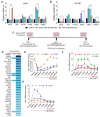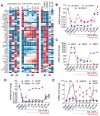IKKβ Inhibition Attenuates Epithelial Mesenchymal Transition of Human Stem Cell-Derived Retinal Pigment Epithelium
- PMID: 37190063
- PMCID: PMC10136838
- DOI: 10.3390/cells12081155
IKKβ Inhibition Attenuates Epithelial Mesenchymal Transition of Human Stem Cell-Derived Retinal Pigment Epithelium
Abstract
Epithelial-mesenchymal transition (EMT), which is well known for its role in embryonic development, malignant transformation, and tumor progression, has also been implicated in a variety of retinal diseases, including proliferative vitreoretinopathy (PVR), age-related macular degeneration (AMD), and diabetic retinopathy. EMT of the retinal pigment epithelium (RPE), although important in the pathogenesis of these retinal conditions, is not well understood at the molecular level. We and others have shown that a variety of molecules, including the co-treatment of human stem cell-derived RPE monolayer cultures with transforming growth factor beta (TGF-β) and the inflammatory cytokine tumor necrosis factor alpha (TNF-α), can induce RPE-EMT; however, small molecule inhibitors of RPE-EMT have been less well studied. Here, we demonstrate that BAY651942, a small molecule inhibitor of nuclear factor kapa-B kinase subunit beta (IKKβ) that selectively targets NF-κB signaling, can modulate TGF-β/TNF-α-induced RPE-EMT. Next, we performed RNA-seq studies on BAY651942 treated hRPE monolayers to dissect altered biological pathways and signaling events. Further, we validated the effect of IKKβ inhibition on RPE-EMT-associated factors using a second IKKβ inhibitor, BMS345541, with RPE monolayers derived from an independent stem cell line. Our data highlights the fact that pharmacological inhibition of RPE-EMT restores RPE identity and may provide a promising approach for treating retinal diseases that involve RPE dedifferentiation and EMT.
Keywords: PVR and AMD; TGF–β/–α; differentiation; epithelial-mesenchymal transition; kinase inhibitors; retinal pigment epithelium; stem cells; transcriptomics.
Conflict of interest statement
RCT is an employee of Caris Life Sciences.
Figures






Similar articles
-
DAPL1 inhibits epithelial-mesenchymal transition of retinal pigment epithelial cells by regulating the TGF-β/MITF pathway.Exp Eye Res. 2025 Sep;258:110473. doi: 10.1016/j.exer.2025.110473. Epub 2025 Jun 2. Exp Eye Res. 2025. PMID: 40466854
-
Effectively Intervening Epithelial-Mesenchymal Transition of Retinal Pigment Epithelial Cells With a Combination of ROCK and TGF-β Signaling Inhibitors.Invest Ophthalmol Vis Sci. 2021 Apr 1;62(4):21. doi: 10.1167/iovs.62.4.21. Invest Ophthalmol Vis Sci. 2021. PMID: 33861322 Free PMC article.
-
Absent in melanoma 2: a potent suppressor of retinal pigment epithelial-mesenchymal transition and experimental proliferative vitreoretinopathy.Cell Death Dis. 2025 Jan 27;16(1):49. doi: 10.1038/s41419-025-07367-9. Cell Death Dis. 2025. PMID: 39870644 Free PMC article.
-
Blockade of Jagged/Notch pathway abrogates transforming growth factor β2-induced epithelial-mesenchymal transition in human retinal pigment epithelium cells.Curr Mol Med. 2014 May;14(4):523-34. doi: 10.2174/1566524014666140331230411. Curr Mol Med. 2014. PMID: 24694299 Review.
-
The intervention of epithelial-mesenchymal transition in homeostasis of human retinal pigment epithelial cells: a review.J Histotechnol. 2022 Dec;45(4):148-160. doi: 10.1080/01478885.2022.2137665. Epub 2022 Nov 15. J Histotechnol. 2022. PMID: 36377481 Review.
Cited by
-
TAB2 Promotes Immune Escape and Chemoresistance Through NF-κB Pathway Activation in Cervical Cancer.J Cell Mol Med. 2025 Mar;29(6):e70522. doi: 10.1111/jcmm.70522. J Cell Mol Med. 2025. PMID: 40133221 Free PMC article.
-
High resolution imaging and interpretation of three-dimensional RPE sheet structure.bioRxiv [Preprint]. 2025 Jan 28:2024.12.04.626881. doi: 10.1101/2024.12.04.626881. bioRxiv. 2025. PMID: 39677811 Free PMC article. Preprint.
-
Molecular Mechanisms of Epithelial-Mesenchymal Transition in Retinal Pigment Epithelial Cells: Implications for Age-Related Macular Degeneration (AMD) Progression.Biomolecules. 2025 May 27;15(6):771. doi: 10.3390/biom15060771. Biomolecules. 2025. PMID: 40563412 Free PMC article. Review.
-
Single-cell and machine learning approaches uncover intrinsic immune-evasion genes in the prognosis of hepatocellular carcinoma.Liver Res. 2024 Nov 12;8(4):282-294. doi: 10.1016/j.livres.2024.11.001. eCollection 2024 Dec. Liver Res. 2024. PMID: 39958919 Free PMC article.
-
Oxidative Stress and Inflammation-Related mRNAs Are Elevated in Serum of a Finnish Wet AMD Cohort.Invest Ophthalmol Vis Sci. 2024 Nov 4;65(13):30. doi: 10.1167/iovs.65.13.30. Invest Ophthalmol Vis Sci. 2024. PMID: 39546296 Free PMC article.
References
Publication types
MeSH terms
Substances
Grants and funding
LinkOut - more resources
Full Text Sources
Molecular Biology Databases
Research Materials

